CHECK ANY OTHER DTCS OUTPUT (IN ADDITION TO DTC P0171 OR P0172)
PERFORM ACTIVE TEST USING INTELLIGENT TESTER (A/F CONTROL)
READ VALUE USING INTELLIGENT TESTER (MAF)
READ VALUE USING INTELLIGENT TESTER (COOLANT TEMP)
CHECK VENTILATION HOSE CONNECTIONS
INSPECT FUEL INJECTOR ASSEMBLY (INJECTION VOLUME)
INSPECT AIR-FUEL RATIO SENSOR (HEATER RESISTANCE)
INSPECT ENGINE ROOM J/B (EFI RELAY, EFI MAIN FUSE)
CHECK HARNESS AND CONNECTOR (A/F SENSOR - ECM)
PERFORM CONFIRMATION DRIVING PATTERN
CHECK WHETHER DTC OUTPUT RECURS (DTC P0171 OR P0172)
DTC P0171 System Too Lean (Bank 1) |
DTC P0172 System Too Rich (Bank 1) |
DESCRIPTION
The fuel trim is related to the feedback compensation value, not to the basic injection time. The fuel trim consists of both the short-term and the long-term fuel trims.The short-term fuel trim is fuel compensation that is used to constantly maintain the air-fuel ratio at stoichiometric levels. The signal from the Air-Fuel Ratio (A/F) sensor indicates whether the air-fuel ratio is rich or lean compared to the stoichiometric ratio. This triggers a reduction in the fuel injection volume if the air-fuel ratio is rich and an increase in the fuel injection volume if it is lean.
Factors such as individual engine differences, wear over time and changes in operating environment cause short-term fuel trim to vary from the central value. The long-term fuel trim, which controls overall fuel compensation, compensates for long-term deviations in the fuel trim from the central value caused by the short-term fuel trim compensation.
If both the short-term and long-term fuel trims are lean or rich beyond predetermined values, it is interpreted as a malfunction, and the ECM illuminates the MIL and sets a DTC.
| DTC No. | DTC Detection Condition | Trouble Area |
| P0171 | With warm engine and stable air-fuel ratio feedback, fuel trim considerably in error to lean side (2 trip detection logic) |
|
| P0172 | With warm engine and stable air-fuel ratio feedback, fuel trim considerably in error to rich side (2 trip detection logic) |
|
- HINT:
- When DTC P0171 is set, the actual air-fuel ratio is on the lean side. When DTC P0172 is set, the actual air-fuel ratio is on the rich side.
- If the vehicle runs out of fuel, the air-fuel ratio is lean and DTC P0171 may be set. The MIL is then illuminated.
- When the total of the short-term and long-term fuel trim values is within 20% (and the engine coolant temperature is more than 75°C [167°F]), the system is functioning normally.
MONITOR DESCRIPTION
Under closed-loop fuel control, fuel injection volumes that deviate from those estimated by the ECM cause changes in the long-term fuel trim compensation value. The long-term fuel trim is adjusted when there are persistent deviations in the short-term fuel trim values. Deviations from the ECM's estimated fuel injection volumes also affect the average fuel trim learning value, which is a combination of the average short-term fuel trim (fuel feedback compensation value) and the average long-term fuel trim (learning value of the air-fuel ratio). If the average fuel trim learning value exceeds the malfunction threshold, the ECM interprets this as a fault in the fuel system and sets a DTC.Example:
The average fuel trim learning value is +38% or more or -32% or less, the ECM interprets this as a fuel system malfunction.
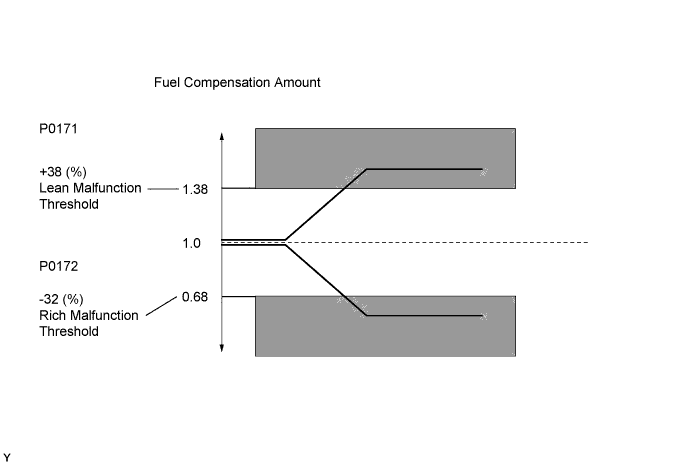
WIRING DIAGRAM
Refer to DTC P2195 (Link).INSPECTION PROCEDURE
- HINT:
- Read freeze frame data using the intelligent tester. The ECM records vehicle and driving condition information as freeze frame data the moment a DTC is stored. When troubleshooting, freeze frame data can help determine if the vehicle was moving or stationary, if the engine was warmed up or not, if the air-fuel ratio was lean or rich, and other data from the time the malfunction occurred.
- A low A/F sensor voltage could be caused by a rich air-fuel mixture. Check for conditions that would cause the engine to run rich.
- A high A/F sensor voltage could be caused by a lean air-fuel mixture. Check for conditions that would cause the engine to run lean.
| 1.CHECK ANY OTHER DTCS OUTPUT (IN ADDITION TO DTC P0171 OR P0172) |
Connect the intelligent tester to the DLC3.
Turn the ignition switch to the ON position and turn the tester on.
Select the following menu items: Powertrain / Engine and ECT / DTC.
Read the DTCs.
- Result:
Display (DTC Output) Proceed to P0171 or P0172 A P0171 or P0172 and other DTCs B
- HINT:
- If any DTCs other than P0171 or P0172 are output, troubleshoot those DTCs first.
|
| ||||
| A | |
| 2.PERFORM ACTIVE TEST USING INTELLIGENT TESTER (A/F CONTROL) |
Connect the intelligent tester to the DLC3.
Start the engine and turn the tester on.
Warm up the engine at an engine speed of 2,500 rpm for approximately 90 seconds.
On the tester, select the following menu items: Powertrain / Engine and ECT / Active Test / Control the Injection Volume for A/F Sensor.
Perform the "Control the Injection Volume for A/F Sensor" operation with the engine in an idling condition (press the RIGHT or LEFT button to change the fuel injection volume).
Monitor the output voltages of the A/F and HO2 sensors (AFS B1 S1 and O2S B1 S2) displayed on the tester.
- Result:
- The A/F sensor reacts in accordance with increases and decreases in the fuel injection volume:
- +25% = Rich output:
- Less than 3.0 V
- -12.5% = Lean output:
- More than 3.35 V
- NOTICE:
- The A/F sensor has an output delay of a few seconds and the HO2 sensor has a maximum output delay of approximately 20 seconds.
| Case | A/F Sensor (Sensor 1) Output Voltage | HO2 Sensor (Sensor 2) Output Voltage | Main Suspected Trouble Area | ||
| 1 | Injection Volume +25% -12.5% |  | Injection Volume +25% -12.5% |  | - |
| Output Voltage More than 3.35 V Less than 3.0 V |  | Output Voltage More than 0.5 V Less than 0.4 V |  | ||
| 2 | Injection Volume +25% -12.5% |  | Injection Volume +25% -12.5% |  |
|
| Output Voltage Almost no reaction |  | Output Voltage More than 0.5 V Less than 0.4 V |  | ||
| 3 | Injection volume +25% -12.5% |  | Injection Volume +25% -12.5% |  | Extremely rich or lean actual air-fuel ratio
|
| Output Voltage Almost no reaction |  | Output Voltage Almost no reaction |  | ||
- Following the "Control the Injection Volume for A/F Sensor" procedure enables technicians to check and graph the voltage outputs of both the A/F and HO2 sensors.
- To display the graph, select the following menu items on the tester: Powertrain / Engine and ECT / Active Test / Control the Injection Volume for A/F Sensor / Enter / View / AFS B1 S1 and O2S B1 S2.
- Result:
Result Proceed to Case 1 C Case 2 B Case 3 A
|
| ||||
|
| ||||
| A | |
| 3.READ VALUE USING INTELLIGENT TESTER (MAF) |
Connect the intelligent tester to the DLC3.
Turn the ignition switch to the ON position and turn the tester on.
Select the following menu items: Powertrain / Engine and ECT / Data List / Primary / MAF and Coolant Temp.
Allow the engine to idle until the Coolant Temp reaches 75°C (167°F) or more.
Read the MAF with the engine in an idling condition and at an engine speed of 2,500 rpm.
- Standard:
- MAF while engine idling: Between 0.54 g/sec. and 4.33 g/sec. (Manual transaxle), Between 0.58 g/sec. and 4.67 g/sec. (Automatic transaxle), (shift position: N, A/C: OFF).
MAF at an engine speed of 2,500 rpm: Between 3.33 g/sec. and 9.17 g/sec. (shift position: N, A/C: OFF).
|
| ||||
| OK | |
| 4.READ VALUE USING INTELLIGENT TESTER (COOLANT TEMP) |
Connect the intelligent tester to the DLC3.
Turn the ignition switch to the ON position and turn the tester on.
Select the following menu items: Powertrain / Engine and ECT / Data List / Primary / Coolant Temp.
Read the Coolant Temp twice, when the engine is both cold and warmed up.
- Standard:
- With cold engine: Same as ambient air temperature.
With warm engine: Between 75°C and 100°C (167°F and 212°F).
|
| ||||
| OK | |
| 5.CHECK VENTILATION HOSE CONNECTIONS |
Check for ventilation hose connections.
- OK:
- Ventilation hose is connected correctly and is not damaged.
|
| ||||
| OK | |
| 6.CHECK AIR INDUCTION SYSTEM |
Check the air induction system for vacuum leakage.
- OK:
- No leakage from air induction system.
|
| ||||
| OK | |
| 7.CHECK FOR SPARKS |
Perform a spark test.
- CAUTION:
- Always disconnect all fuel injector connectors.
- NOTICE:
- Do not crank the engine for more than 2 seconds.
Remove the ignition coil from the cylinder head.
Install the spark plug onto the ignition coil.
Disconnect the 4 fuel injector connectors.
Attach the spark plug assembly to the cylinder head.
Crank the engine for less than 2 seconds and check for sparks.
- OK:
- Sparks jump across electrode gap.
Reconnect the 4 fuel injector connectors.
Install the ignition coil.
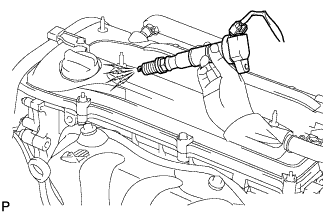 |
|
| ||||
| OK | |
| 8.CHECK FOR EXHAUST GAS LEAK |
Check for exhaust gas leakage.
- OK:
- No gas leakage.
|
| ||||
| OK | |
| 9.CHECK FUEL PRESSURE |
Check the fuel pressure (CAMRY_ACV40 RM000000YCR00RX_01_0002.html).
- Standard pressure:
- 304 to 343 kPa (3.1 to 3.5 kgf/cm2, 44.1 to 49.7 psi)
|
| ||||
| OK | |
| 10.INSPECT FUEL INJECTOR ASSEMBLY (INJECTION VOLUME) |
Check the injection volume (CAMRY_ACV40 RM000000YCT00PX_01_0001.html).
- Standard injection volume:
- 76 to 92 cm3 (4.6 to 5.6 cu in.) per 15 seconds
|
| ||||
| OK | |
| 11.INSPECT AIR-FUEL RATIO SENSOR (HEATER RESISTANCE) |
Disconnect the C15 A/F sensor connector.
 |
Measure the resistance between the terminals of the A/F sensor connector.
- Standard resistance:
Tester Connection Specified Condition HA1A (1) - +B (2) 1.8 to 3.4 Ω at 20°C (68°F) HA1A (1) - A1A- (4) 10 kΩ or higher
Reconnect the A/F sensor connector.
|
| ||||
| OK | |
| 12.INSPECT ENGINE ROOM J/B (EFI RELAY, EFI MAIN FUSE) |
Inspect the EFI MAIN fuse.
Remove the EFI MAIN fuse from the engine room J/B.
Measure the EFI MAIN fuse resistance.
- Standard resistance:
- Below 1 Ω
Reinstall the EFI MAIN fuse.
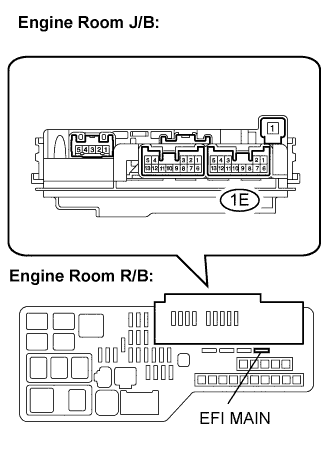 |
Inspect the EFI relay.
Remove the engine room J/B from the engine room R/B.
Measure the EFI relay resistance.
- Standard resistance:
Tester Connection Specified Condition 1E-7 - 1E-12 10 kΩ or higher Below 1 Ω
(Apply battery voltage between terminals 1E-9 and 1E-11)
Reinstall the engine room J/B.
|
| ||||
| OK | |
| 13.CHECK HARNESS AND CONNECTOR (A/F SENSOR - ECM) |
Disconnect the C15 A/F sensor connector.
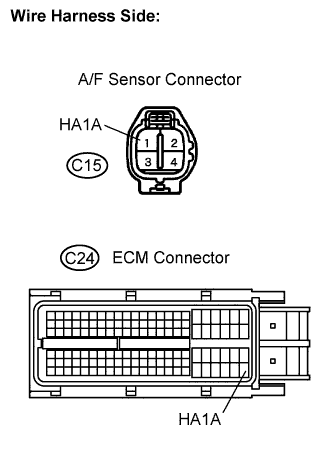 |
Disconnect the C24 ECM connector.
Measure the resistance between the terminals of the wire harness side connectors.
- Standard resistance (Check for open):
Tester Connection Specified Condition HA1A (C15-1) - HA1A (C24-109) Below 1 Ω
- Standard resistance (Check for short):
Tester Connection Specified Condition HA1A (C15-1) or HA1A (C24-109) - Body ground 10 kΩ or higher
Reconnect the A/F sensor connector.
Reconnect the ECM connector.
|
| ||||
| OK | |
| 14.REPLACE AIR-FUEL RATIO SENSOR |
| NEXT | |
| 15.PERFORM CONFIRMATION DRIVING PATTERN |
Connect the intelligent tester to the DLC3.
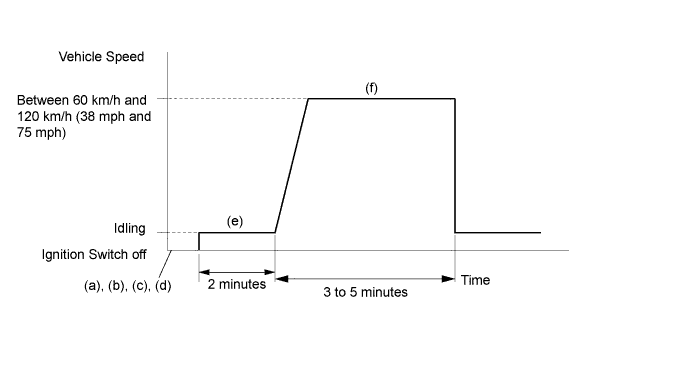
Turn the ignition switch to the ON position and turn the tester on.
Clear the DTCs (CAMRY_ACV40 RM000000PDK0D5X.html).
Switch the ECM from normal mode to check mode using the tester (CAMRY_ACV40 RM000000PDL01VX.html).
Start the engine and warm it up with all the accessories switched OFF.
Drive the vehicle at between 60 km/h and 120 km/h (38 mph and 75 mph) and at an engine speed of between 1,400 rpm and 3,200 rpm for 3 to 5 minutes.
- HINT:
- If the system is still malfunctioning, the MIL will be illuminated during step (f).
- NOTICE:
- If the conditions in this test are not strictly followed, no malfunction will be detected.
| NEXT | |
| 16.CHECK WHETHER DTC OUTPUT RECURS (DTC P0171 OR P0172) |
On the intelligent tester, select the following menu items: Powertrain / Engine and ECT / DTC.
Read the DTCs.
- Result:
Display (DTC Output) Proceed to No output A P0171 or P0172 B
|
| ||||
| A | ||
| ||